If you wish to hunt Muley bucks in Canada, and want to cross the border with your firearm – here is a site to visit for information:
Mule Deer Fanatic
Bringing the Mule Deer world together, one hunter at a time
Archive for category Mule Deer Hunting
Why be a Mule Deer Fanatic?
What is the point in being a Mule Deer Fanatic?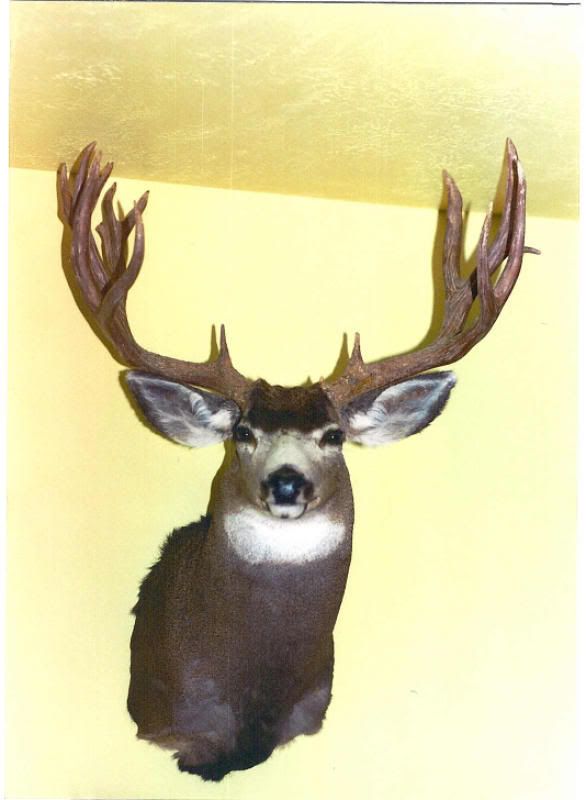
It’s always nice to see mule deer, especially a large buck. You can always enjoy stalking a buck. Photographing mule deer is also very enjoyable. Reading about mule deer is exciting. Hunting mule deer, if you can draw a tag, is getting right up there. Ultimately, though, a mule deer fanatic wants to harvest a trophy buck. If one is fortunate enough to have several trophies on the wall, that person really qualifies as a mule deer fanatic.
In order to frequently have the opportunity for a trophy buck, there has to be an investment ( and an incentive ). The investment may be made by purchasing expensive, high-quality, guided hunts. Alternatively, success can be achieved by a DIY hunter who simply has a lot of tenacity, desire, and knowhow. Some have been fortunate enough to have access to great mule deer hunting by owning enough of the right property.
I believe it is getting harder and harder to be consistently successful. One thing that every mule deer fanatic needs to do is exert influence, as much as possible, toward better mule deer management. One should not consider himself a true mule deer fanatic without doing all in his power to promote an abundance of mule deer.
The idea of abundance has not been a high priority for game managers. It is, in fact, scarcity that is most popular today. Game managers must cease their love affair with predators before we will ever see abundance again. Weather, habitat, human encroachment, hunting, and even poaching combined do not cause the scarcity that is caused by predation.
If you want to be classified as a mule deer fanatic, I believe you need to be like a nagging child that won’t go away – when it comes to voicing your wishes to those that are in control. Interestingly, individual game biologists are not in control, even though you should certainly talk to them. Even heads of departments are not that influential. None of them is elected. You really need to go after state Governors and legislators, who are elected. However, if you want to get to the top, then talk to the US Fish and Wildlife Service, or more importantly the Mule Deer Working Group. I believe this group has become the major factor in keeping scarcity in place. They would much rather fund a study to prove that predators don’t have a negative impact on deer, than to fund serious predator control – the former accomplishing nothing and the latter benefitting mankind.
Here is a link to this group. 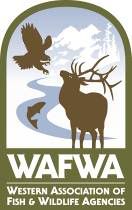 I wish that all mule deer fanatics, everywhere, would overwhelm this group with a common cause – mule deer abundance. Read their conservation plan and you will realize that “conserve” means to feed predators and reduce hunting. If you don’t like that too well – then do something about it. Send an email to every person in the group and let them know that abundance will not be achieved until predators are controlled, and that when mule deer are once again abundant, then we will consider feeding the predators. Show that you are a dyed-in-the-wool, true-blue MULE DEER FANATIC.
I wish that all mule deer fanatics, everywhere, would overwhelm this group with a common cause – mule deer abundance. Read their conservation plan and you will realize that “conserve” means to feed predators and reduce hunting. If you don’t like that too well – then do something about it. Send an email to every person in the group and let them know that abundance will not be achieved until predators are controlled, and that when mule deer are once again abundant, then we will consider feeding the predators. Show that you are a dyed-in-the-wool, true-blue MULE DEER FANATIC.
Are Mule Deer Color Blind?
I’m going to start right off telling you that I am color blind. Years ago, I read an article that said deer are color blind. I think it would be hard to know. I’ve asked – but those darned deer just won’t tell me. I won’t go into detail, but after observing over many years, and after doing some experiments of my own, I believe mule deer are color blind.
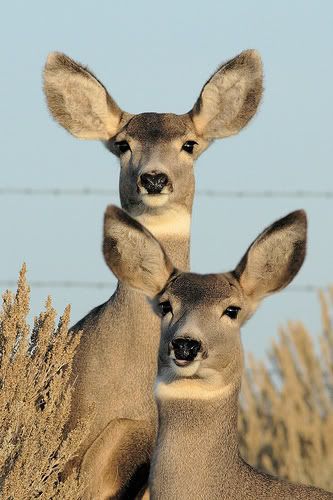
What does this mean to the hunter? Well, it is very difficult, at best, for a color blind person to explain what he sees to a “normal” person. But, if I can get you to understand what I see, you may have a comparitive advantage over your fellow hunters when it comes to hunting (particularly bowhunting) mule deer.
It is rumored that color blind soldiers were used in world war II to spot ground camoflauge from airplanes. You see (maybe you don’t), to a color blind person, camoflauge is not camoflauge at all; it stands out somewhat like a neon light. Are you starting to see the picture? All you guys/gals that think you’re hiding from the mule deer are just making yourselves more obvious. If you are wearing camo, for heck sakes, don’t move.
The author of the aforementioned article said that deer see black, white, grey, and yellow. I’m not sure that is completely accurate. I find it reasonable to believe that they see like I do. Let me explain how I see, if I can. In the summer, when deer are reddish (so I’m told), I cannot see them unless they move. They blend in perfectly with their surroundings. I know this may be hard for you to understand. In the fall, when the deer are grey, then I can spot them like they were blinking. Go figure.
My hunting partner, of many years, has the quirky trait of having deer just stand around and gawk at him, while they run from me.
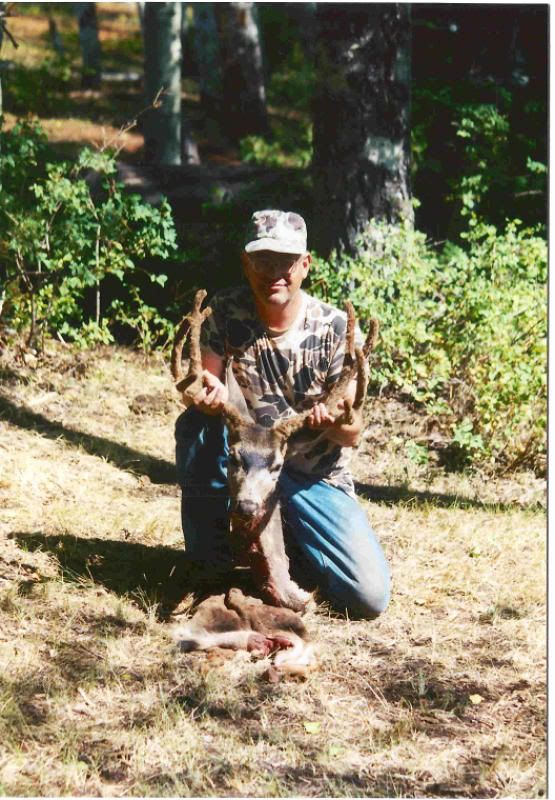 I tell him it is because he looks funny with those thick glasses he wears ( he is legally blind, I am legally color blind). This has always annoyed me, and many times I have sworn to remedy the situation. One year, I had my daughter build me a hat with big mule deer ears on it. I chose the color green, even though I couldn’t tell it was green, because I surmised that the hunters would know I wasn’t a deer, but the deer wouldn’t. It was a real neat trick – until the ears started drooping like dog ears. The deer didn’t like that. They didn’t stand around gawking for very long, once those ears got droopy. But, it did cause them to gawk when the ears were upright.
I tell him it is because he looks funny with those thick glasses he wears ( he is legally blind, I am legally color blind). This has always annoyed me, and many times I have sworn to remedy the situation. One year, I had my daughter build me a hat with big mule deer ears on it. I chose the color green, even though I couldn’t tell it was green, because I surmised that the hunters would know I wasn’t a deer, but the deer wouldn’t. It was a real neat trick – until the ears started drooping like dog ears. The deer didn’t like that. They didn’t stand around gawking for very long, once those ears got droopy. But, it did cause them to gawk when the ears were upright.
Here is some color-related advice from a color blind person. The main color to avoid is white. Yellow is not too far behind. Blue would be next on my list. Most camoflauge on the market, even though there have been improvements, is bad. If you want to be seen by hunters, but not by deer use bright red. I think you should know, there is no such thing as bright red for the color blind. Flourencent orange does nothing to impress a color blind person either. Get 100 yards away with your flourescent orange and it might as well be drab green. As far as a single, good color goes, drab green is a good one. But, if you really want to hide from deer, look like a coyote or a lion. Theirs is a terrific camoflauge against color blindness. Sagebrush green/grey is also very good. Now you know.
Happy Hunting and may the Force be with you.
Developing skill with your weapon and equipment
There is nothing like on-the-job training. When you cannot hunt mule deer, by all means hunt rabbits, squirrels, gophers, coyotes, etc. Especially coyotes.
Mule deer stot, which is to say they bounce like they are on pogo sticks while they run.
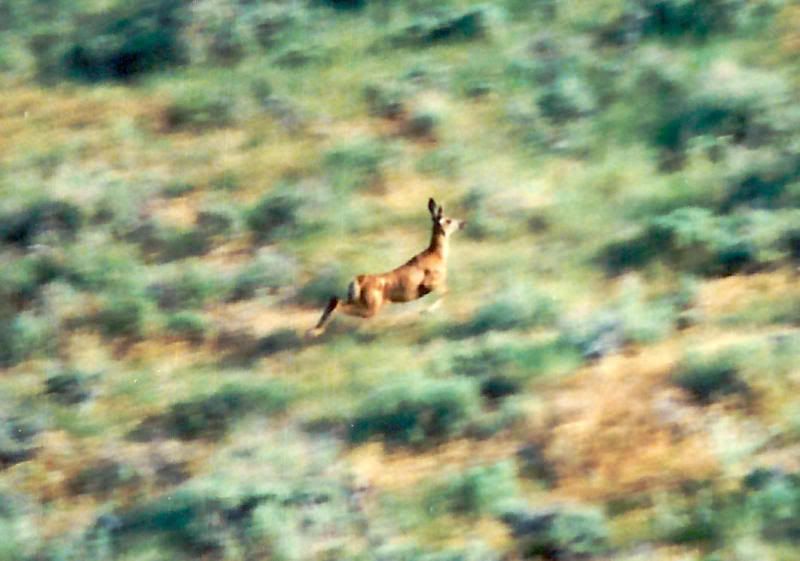 When you can hit a running mule deer, you are doing good – even if it is luck. It is better to shoot at a mule deer that is standing still, but if that is the only shot you can/will take, you limit your potential. One hunter, I know, practices with his target inside a tire, and rolls the tire down a hill while trying to shoot the bullseye. This may be extreme, but it has paid off for him. Be creative, but not dangerous.
When you can hit a running mule deer, you are doing good – even if it is luck. It is better to shoot at a mule deer that is standing still, but if that is the only shot you can/will take, you limit your potential. One hunter, I know, practices with his target inside a tire, and rolls the tire down a hill while trying to shoot the bullseye. This may be extreme, but it has paid off for him. Be creative, but not dangerous.
Your choice of weapon, caliber, or model is less important than your skill with it. I have my preferences, which I will share, but so does everyone else. My favorite for mule deer is a M-77 Ruger .25-06 handloaded with 120 gr. rapid-expansion boat-tail bullets. My binoculars are Swarovski 10×42’s. I use a Leopold 3-9 rifle scope. If you are a serious mule deer fanatic, your equipment may get some rough treatment. Yours should be able to handle whatever you will dish out, without you feeling guilty about some scars and scrapes.
If you plan to do a lot of “noclarating”, get some “noclars” that don’t give you a headache after lengthy use. I find that the heavier binoculars are easier to hold steady when you are shaky. Both binoculars and rifle scopes have a tendency to fog up when you least desire it. Those that are resistive to fogging are valuable.
When buck fever sets in, strange things happen. You want the proper and correct use of your equipment to be able to go on autopilot when you get buck fever. This requires repetition. Practice, practice, practice.
If your first unaided view of a buck tells you he is a potential keeper, look at him with your rifle scope instead of your binoculars.
Finally, be able to make a quick shot, if necessary. Don’t, however let your quick shot rule over good judgement.
Happy hunting and may the Force be with you
Getting in shape to hunt Mule Deer
I know persons who have shot mule deer from the seat of their atv or vehicle. No discussion of legalities here. If you really want to hunt mule deer, you can still find places and methods that do not require you to be in physically good condition. Improving your condition, in any instance, will only make your hunt more enjoyable and beneficial. I look forward to the hunt every year because it gives me an incentive (which I otherwise lack) to get in shape, and also gets me in even better shape by the doing.
There is a lot of mule deer country that is rugged, remote, hairy, wild, and wooley. If you want the real thrill of the hunt go to such areas. Some mule deer have mountian goat blood in their genetics. Your chances for a trophy mule deer are improved by getting off the beaten path. Any exercise will help, I suppose – but, in my opinion, the only activity that is really up to the task is the task itself. Go to the area you plan to hunt, if at all possible, and hike like a crazy man. Scout for deer while your at it, and kill two birds with one stone. If you cannot do this, mimic it as closely as you possibly can. Unless it kills you, it will help you.
Happy hunting and may the Force be with you
Your Guide to start hunting Mule Deer
So, you want to hunt mule deer….
Well, if you’re like me, I’ve always wanted to hunt whitetail, but have never done anything about it. Maybe you fall in that category relative to mule deer hunting. Maybe you live in the east and don’t know where to go or what to expect. So, let’s get you on your way and answer some questions for you. If you have other questions, let me know.
First, see the topic: “All about Mule Deer“, if you believe it will help you.
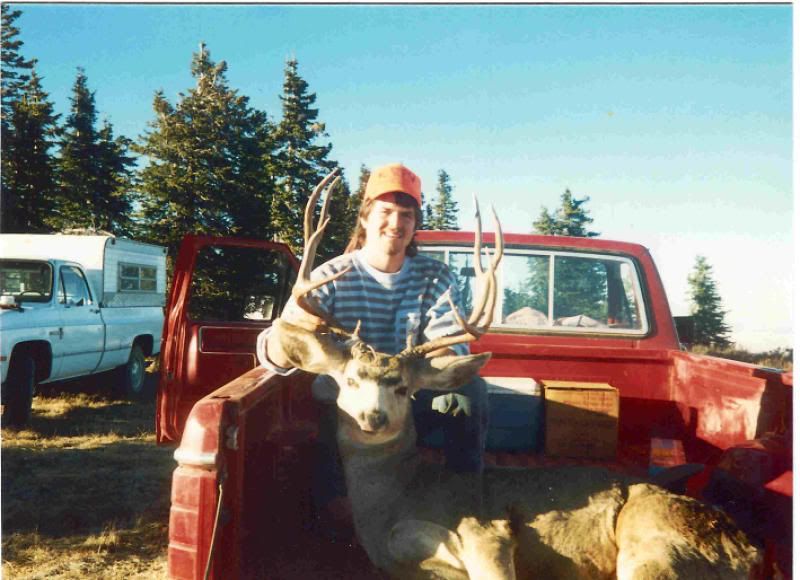
Second, Be in shape for high altitudes and rugged terrain. The best practice is hard hiking up and down steep hills.
Third, Westerners count antler points differently than Easterners. The equivalent of a whitetail 10 point would normally be referred to as a 4 pt mule deer, or a 4×4. Set your goals realistically, but I recommend that you shoot for a 4 pt, or better, if you are going to spend the time and money to hunt mule deer.
Fourth, Mule deer are largely creatures of big, relatively wide-open expanses. Expect to take, and practice taking what, to you, may seem like long shots. 500 yards is not unreasonable.
Fifth, You may expect to haul a mule deer quite a long distance over some difficult terrain in order to get it to your vehicle. If you can’t do this immediately, beware of predators and endeavor to keep your animal away from them.
Sixth, Just before a spooked mule deer disappears from your view, it will often stop a moment to assess what your next move will be. This is often a golden opportunity. Once the mule deer disappears, however, they will typically do the unexpected until you learn to expect the unexpected.
Seventh, Most states have lotteries for mule deer hunts. Many have preference or bonus points for the undrawn hunter in order to improve his/her odds of drawing in subsequent years. Some states make you pay for these points, some do not. Start applying today in order to hunt tomorrow. You will nearly always need the license in order to apply for the tag. Some states won’t refund your license (fee), if you don’t draw. In that case, go kill some lions and coyotes to allow for more deer the next year – put your license to good use.
Eighth, There are golden opportunities for archery hunters, especially if you are a competent archer.
Ninth, Plan on covering a lot of ground to see mule deer. They move around over a much larger area than whitetails. Use your instinct, which is often correct, to tell you when you are very near deer. Then, become as stealthy as you can.
Tenth, Mule deer love transition zones. This is where there is a fundamental change in vegatation, usually due to elevation. In such areas, deer have a larger variety of feed and cover.
Eleventh, Mule deer will stay relatively close to water. One Mexican sheep herder put it this way: “Water – deer. Deer – water.”
Twelveth, Don’t be a noisy hunter unless your strategy is to spook the deer so you can see them.
Thirteenth, Even though mule deer have large, respectable ears; and eyes that are super-sensitive to movement – the nose is where it’s all at. The nose is never doubted, even though the eyes and ears sometimes are. Be Aware of the wind and your scent. A wise old buck will sneak away upon hearing or smelling you before you see him. Mule deer behave as if you can smell them – they don’t know you can’t. They also behave as if you can see in the dark.
Fourteenth, When a group of does and/or small bucks breaks cover and runs, be extra keen on watching for a big buck doing something entirely different than the herd.
Fifteenth, If you jump a mule deer, and do not spook it too badly, you can wait patiently and it will quite often return. Watch the wind though.
Sixteenth, Big bucks will bed in such a way that other bedded deer protect them from intruders. If you come upon a bedded doe, don’t spook her just because she is not a buck. Look around for the buck first, and remember the first sentence while you’re looking.
Seventeenth, Mule deer are usually bedded by one hour after sun-up. They usually start moving around again when the evening shadows cool things down a bit.
Eighteenth, Mule deer can’t be rattled or called very effectively – like whitetails. If you use a fawn distress call – expect the does to charge you and the bucks to flee from you. Since there are now few, if any, rut hunts – calling and rattling are pretty useless.
Ninteenth, Mule deer hunters have a nasty habit of moving past you in the dark – quite often spooking deer for both you and them. Such hunters believe they should be in their favorite spot before sun-up.
Twentieth, Carry good binoculars. Hunting mule deer without them is tough at best. Keep them handy.
Lastly, dress in layers. Temperatures and weather can change rapidly in mule deer country. Be able to start a fire in extremely difficult circumstances, including you shaking so badly that you can scarcely strike a match.
Happy hunting and may the Force be with you
Top 10 for the New Mule Deer Hunter
1) Get in shape. Go up and down steep hills – there’s nothing better.
2) Develop in-the-clutch skill with your weapon and equipment. Buck fever happens.
3) Pick a hunting area that has the kind of bucks you expect to harvest.
4) Obtain the necessary finances. Credit card expiration dates need to go beyond fee withdrawl dates.
5) Apply for and obtain a license and tag. Some states start this process as early as January. Most have online applications.
6) Preseason scouting. If possible, select the buck you will harvest.
7) Attitude is important : Apply faith, enthusiasm, effort, and skill to your hunt.
8 If one spot doesn’t produce, quickly switch to another. Be flexible.
9) Hunt dawn ’til dark.
10) Expect to succeed. Take a knife, rope, deer bag, salt, baking soda, camera, and anything else necessary for when your buck is on the ground.
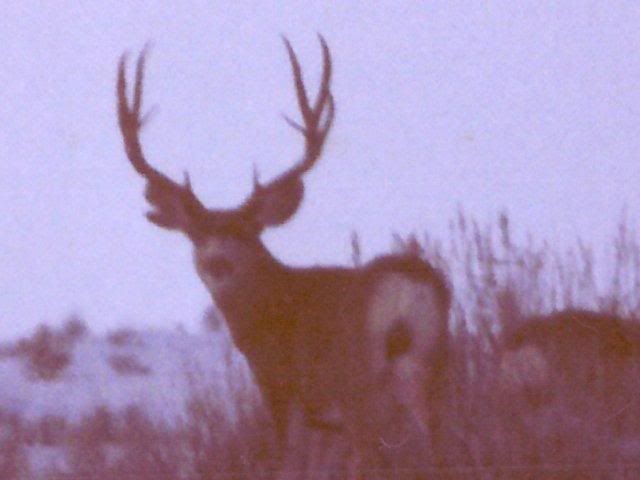
Happy hunting and may the force be with you
Droughts and Harsh Winters, not the problem
Harsh winters and droughts have always impacted mule deer. As far as I’m concerned, they always will, especially if a harsh winter immediately follows a severe drought. We have always had weather and will continue to do so – with little or nothing we can do about it.
In the good old days, and I’m old enough to have seen them, mule deer rebounded very quickly after bad weather. Why? Well, they are nearly like rabbits, if they’re allowed to be. The old-timers, two generations before me, said mule deer used to be called “government mutton”, and were like herds of sheep. I was fortunate enough to see the tail-end of those days.
Nowadays, if game agencies see a 0.5/1.0 fawn to doe ratio – they brag about it. If you were a sheepman and had that kind of ratio – you’ld be outabusiness. Healthy herds of both deer and sheep should have 1.8/1.0 baby/mom ratios. Deer herds with those kind of ratios can, and do rebound quickly.
Why don’t we have those kind of ratios anymore? Primarily coyotes. Again, if sheepmen let the coyotes reduce their ratios to even 1.0/1.0 – they’re outabusiness.
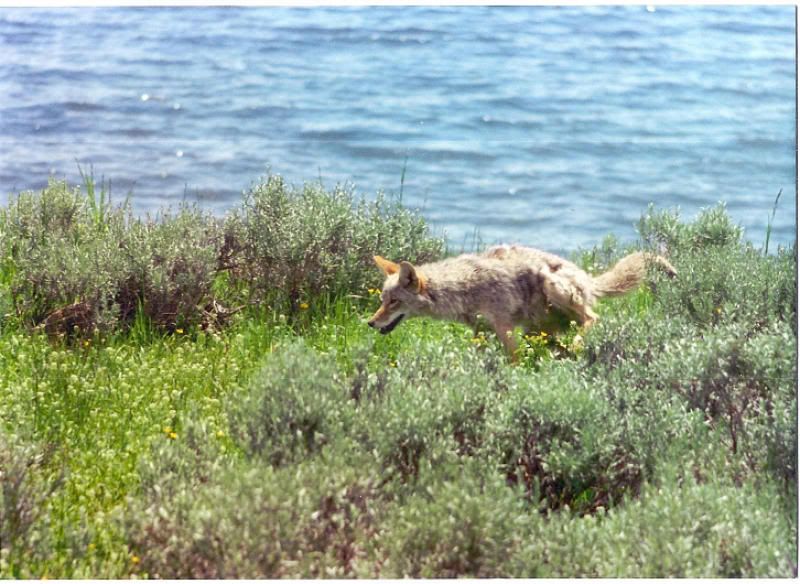 Coyotes are getting most of our fawns before they can even be counted. And, coyotes aren’t the only problem. In my home area, birds of prey (and coyotes, as well) kill fawns while they are being born. (You may also observe, that in the mule deer heyday – birds of prey weren’t protected, and were often shot on sight). Even crows will peck the eyes out of a mule deer fawn during birth, and finish up later. Another, but lesser problem affecting fawn/doe ratios, is females not getting bred or getting bred late. In Arizona, we have to kill 30,000 coyotes per year just to break even. Other states are not much different.
Coyotes are getting most of our fawns before they can even be counted. And, coyotes aren’t the only problem. In my home area, birds of prey (and coyotes, as well) kill fawns while they are being born. (You may also observe, that in the mule deer heyday – birds of prey weren’t protected, and were often shot on sight). Even crows will peck the eyes out of a mule deer fawn during birth, and finish up later. Another, but lesser problem affecting fawn/doe ratios, is females not getting bred or getting bred late. In Arizona, we have to kill 30,000 coyotes per year just to break even. Other states are not much different.
Yes, there are getting to be more and more people. Yes, there are fewer resources (mule deer) and, WE CAN DO SOMETHING ABOUT IT. In the late sixties, when I first started hunting mule deer, there were 210,000 hunters in my home state of Utah ( 1/3 of all Utahns, 2/3 of the Utah males) and we harvested app. 80,000 bucks per year for quite a few years. Now there are no more than 97,000 deer hunters in Utah, and they harvest less than 25,000 mule deer (male and female) (And that’s being generous -I don’t believe the DWR numbers). It doesn’t matter how many people there are per se, only how many hunters.
Now, I’m going to try and jump one step ahead of you – in case you want to tell me about human encroachment. The undeveloped areas next to cities haven’t been much good for mule deer for a long time. The last time mule deer hunting was really good along the Utah Wasatch front was 1969. We haven’t lost much to encroachment in that area for 40 years. Interestingly, mule deer along the Wasatch front are more abundant now than they were 30 years ago… it’s all those nice neighborhoods with watered shrubs and such.
All over the rest of Utah, and in large areas of other western states – things haven’t changed a lot. Blanding, Utah; or Rockland, Idaho; or Jackpot, Nevada; or North Kaibab, Arizona – for example. I can remember when cedar trees, all over the West, were eaten up as high as the mule deer could reach, and still we sustained large deer herds, and had large harvests year after year. The number of people ISN’T the problem, as politically popular as that idea is.
What is the problem? (and fortunately, it is one that we can do something about): PREDATORS. Every western state has maxed out its lion population. Lions will eat 50 deer a year, avg., if the deer are available. There doesn’t need to be a lot of discussion about that. Just pause and do some math using however many lions you think there are. Good weather won’t help reduce the lion impact, either.
I have a good friend who has the solution: Everyone who turns in 3 coyote ears or one lion ear gets a free deer tag from their state agency. Everyone wins! And, think of all the deer we “conserve”.
My father, who taught me to hunt, would not let me shoot a doe. He said that in 5 years I would have killed the equivalent of 25 deer by killing one doe. That is another problem we can do something about. We don’t need to kill does until we exceed carrying capacity. And, if you start talking to me about how killing does (politically correct) improves deer herds, be prepared for a rebuttal.
Winter Range, National Parks, and Mule Deer
Many will argue that the real problem with declining mule deer populations is deteriorating winter habitat, and that National Parks are evidence that habitat, not predation, is the limiting factor in mule deer populations. If you broaden your view a little you will see that, in many areas, there is virtually unlimited winter range but limited summer range. Summer range, not winter range, controls the carrying capacity of the mule deer in those areas. It is almost always the case that the summer range in any area can support significantly more mule deer than are currently present. And still the deer are no longer able to increase to the level of the summer range capacity.
In those areas where the limiting factor is winter range, there are 3 different conditions that are typically cited as important: 1) quality of browse; 2) quantity of browse; or 3) scarcity of cover. It is difficult, at best, to assess the quality of the browse. It has been assumed that older plants such as sage brush, have lower quality than young plants. I have participated in reseeding projects, some of which have now had years to develop. I have observed areas where juniper have been removed. I have also observed numerous controlled burns. None of these, however wonderful they may be, have brought back the mule deer in the affected areas.
There are numerous areas where the quality of the browse has improved even in non-conventional ways – such as in subdivisions which are planted with lush, green, well-cared for browse. In some areas the quality of browse has degraded because of decreased use by domestic livestock. If livestock do not overgraze an area, they can actually improve the quality of the browse for mule deer.
Concerning the quantity of browse, there are probably as many areas where the quantity of browse has increased as there are areas where it has decreased. One reason for this is that far fewer deer are consuming the plants than was the case in the past. With few exceptions, there is in every area adequate quantity of browse for more mule deer than are present. In years when there is deep snow, the snow can effectively reduce the quantity of feed available to the mule deer.
Because of snowmobiles, atv’s, high numbers of domestic dogs, and such – mule deer are harassed in winter time more than they used to be. If their cover is not adequate, the stress from harassment is compounded by the lack of cover. There may end up being a greater distance separating cover from browse- increasing the likelihood of exposure. Mule deer are nervous creatures anyway and harassment during winter degrades their health with or without cover. Unbroken expanses of Juniper do not help deer much, but a mosaic of trees and browse is highly desirable.
For those who believe that predators don’t have any negative impact on mule deer, and that pristine vegation is better than manipulated vegetation, the National Parks should then have such an abundance of mule deer as to make the deer a nuisance. Such is not the case, there are fewer mule deer in National Parks than in the areas surrounding the Parks. The deer in the Parks are typically more visible, but are not more plentiful. Yellowstone is a classic example of the impact of predation in the presence of pristine habitat. The habitat has not saved the game from predators. Since the introduction of wolves in Yellowstone, the game animals have diminished drastically with no apparent change in habitat.


